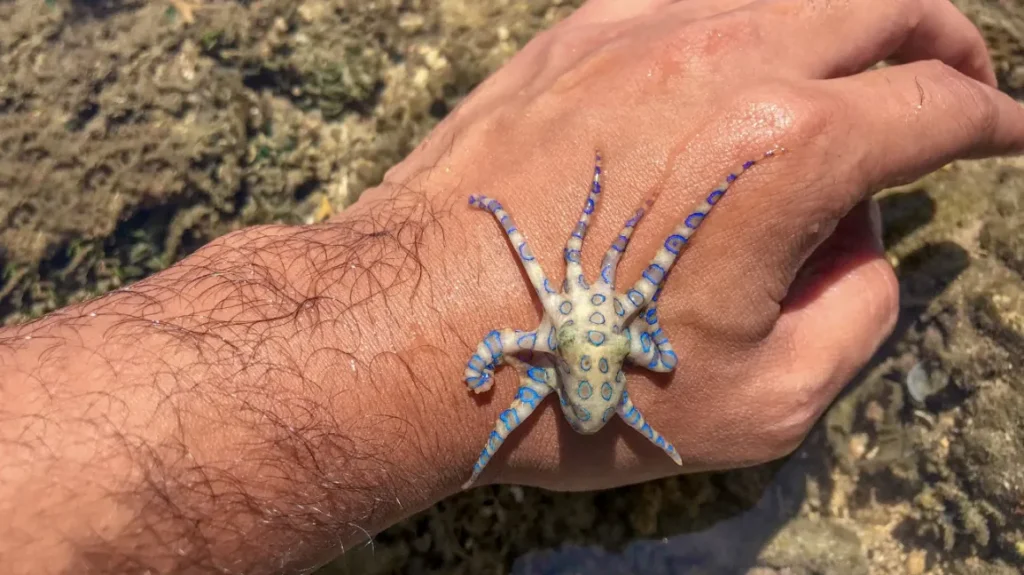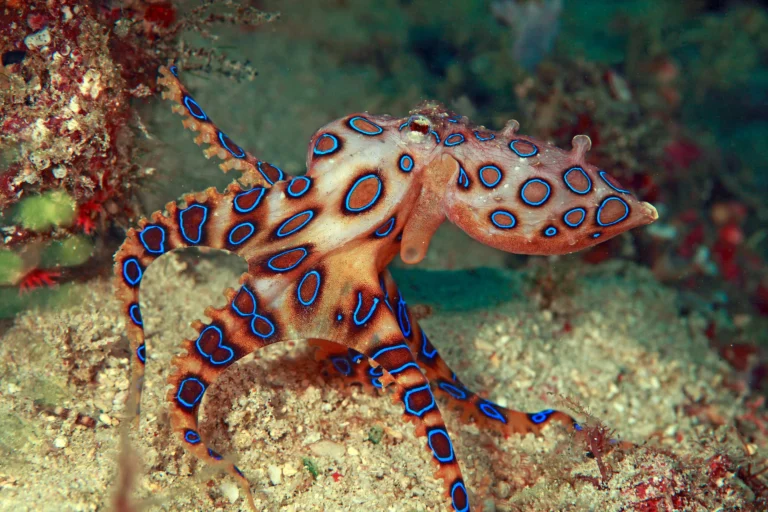Dainty in size yet packed with intrigue and venom, the blue-ringed octopus is one of the ocean’s most fascinating cephalopods. With its distinctive, luminescent rings and remarkable biology, this creature captivates divers, marine biologists, and ocean enthusiasts worldwide. This article will guide you through the world of the blue-ringed octopus, exploring its biology, behaviour, and the significance of its venomous bite.
Physical Characteristics and Habitat of The Blue-Ringed Octopus
The blue-ringed octopus is named for its vibrant, neon-blue rings that stand out starkly against its yellowish skin. Although generally small—measuring up to 20 cm (8 inches) in length—the octopus’s bright coloration makes it a striking presence in the underwater realm.
Native to the Pacific and Indian Oceans, the blue-ringed octopus can typically be found in tide pools and coral reefs. Their preference for shallow, warm waters often puts them in close proximity to humans, especially in regions like Australia.
Behaviour and Diet of The Blue-Ringed Octopus
Camouflage is a critical skill for the blue-ringed octopus, which, despite its venomous bite, remains a tasty target for larger marine predators. When not threatened, the octopus’s rings are often faint or entirely invisible. It’s only when the creature senses danger that the rings become bright and iridescent—a warning sign to potential threats.
The blue-ringed octopus diet primarily consists of small crustaceans, including crabs and shrimp. Using a paralysing venom to immobilise their prey, they use their beak to deliver a fatal bite and consume their catch.
Venom and Danger to Humans
The blue-ringed octopus’s venom contains tetrodotoxin, an extremely potent neurotoxin that can be deadly to humans. In fact, gram for gram, tetrodotoxin is up to 1,200 times more toxic than cyanide. While the octopus itself is unassuming in appearance, it carries enough venom to kill multiple adult humans.
However, attacks on humans are rare and typically occur when the octopus feels threatened or is inadvertently stepped on or handled by unaware beachgoers or divers. A bite from a blue-ringed octopus is often painless, but symptoms—ranging from numbness to respiratory failure—can manifest within minutes.
It’s crucial to note that there is no known anti-venom for a blue-ringed octopus sting. Immediate medical treatment, including artificial respiration, can be lifesaving if a person is envenomated.
Conservation and Significance
While the blue-ringed octopus is not currently listed as endangered, it, like many marine creatures, faces threats from habitat loss, pollution, and climate change. As sentinel species, their well-being can provide insights into the overall health of their marine environment.
Additionally, the very venom that makes the blue-ringed octopus so dangerous is also of significant interest to the medical community. Research is underway to explore the potential therapeutic uses of tetrodotoxin, including as a potent painkiller.
Ecology and Reproduction
One of the fascinating aspects of the blue-ringed octopus is its reproductive behaviour. These octopuses have a relatively short lifespan, usually around one to two years. As with many cephalopods, their life is characterised by a single, intense reproductive period followed by a swift decline and death.
When it’s time to mate, the male uses a specialised arm called the hectocotylus to transfer sperm packets to the female. After mating, females lay their eggs in hidden crevices or under rocks, carefully guarding them until they hatch. The mother’s dedication to her brood is so profound that she won’t leave even to hunt, leading to her eventual death after the eggs hatch.
The young octopuses, upon hatching, are planktonic, meaning they become part of the ocean’s vast microscopic ecosystem. They drift in this larval stage until they grow large enough to settle on the ocean floor and begin their benthic, or bottom-dwelling, lifestyle.
Human Interactions and Safety

As mentioned earlier, the blue-ringed octopus is highly venomous, and encounters can be fatal for humans. However, these creatures are not naturally aggressive. Most incidents occur when they are accidentally provoked. With the increasing popularity of marine activities, such as snorkeling and scuba diving, it’s crucial to be informed about the potential risks and how to avoid them.
When diving or exploring tide pools in regions where the blue-ringed octopus is native, it’s advisable not to touch or handle marine life. Not only does this protect individuals from potential envenomation, but it also reduces stress on the creatures and preserves their natural habitat.
Cultural Significance
The blue-ringed octopus holds a particular cultural significance in regions where they are found. Indigenous communities in Australia, for instance, have long been aware of this creature’s deadly potential and have incorporated it into local lore and cautionary tales. In recent years, the octopus’s stunning appearance has also made it a popular subject in photography, artwork, and marine documentaries, further amplifying its global recognition.
The Way Forward: Research and Conservation
The mysteries of the blue-ringed octopus are gradually being unveiled through scientific research. Studies are delving into its venom composition, hunting strategies, and even its genetic makeup to better understand this remarkable creature.
Conservation efforts are paramount. As with many marine species, safeguarding the habitats of the blue-ringed octopus is a step towards ensuring their survival. Establishing marine protected areas, reducing pollution, and promoting responsible marine tourism are all strategies that can help in conserving this enigmatic creature and the delicate ecosystems it inhabits.
See how organisations are aiding in Blue Ringed Octopus conservation here.
Conclusion: A Symphony of Wonder and Caution
In wrapping up our exploration of the blue-ringed octopus, it becomes clear that this creature is a symphony of wonder and caution. Its vibrant rings and unique behaviours captivate our imagination, while its potent venom serves as a stark reminder of nature’s inherent power. By continuing to study, respect, and protect the blue-ringed octopus, we can hope to ensure its presence in our oceans for generations to come.
UP NEXT
The Life & Habits of The Atlantic Bluefin Tuna
Beluga Whales: The Playful Arctic Spirits of the Sea



